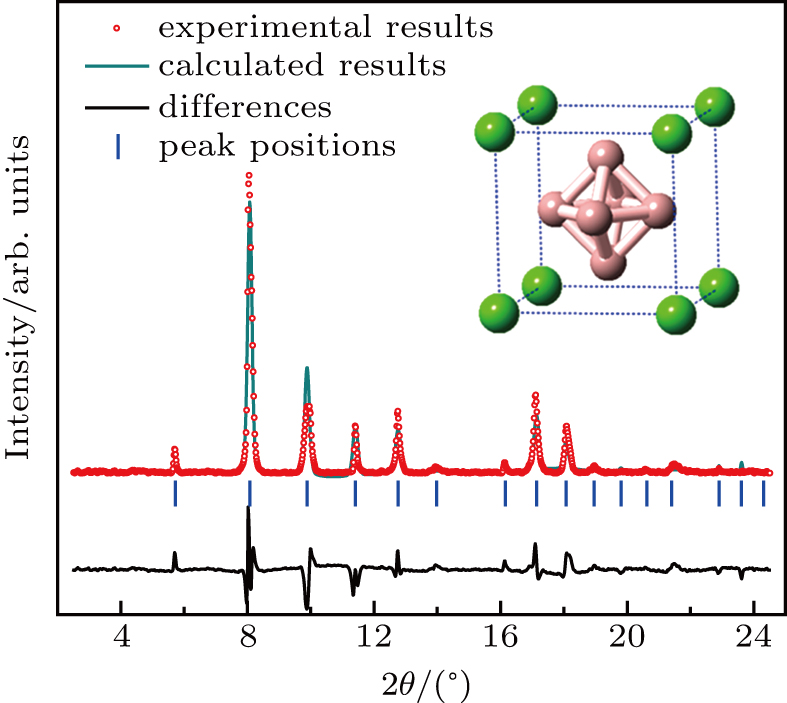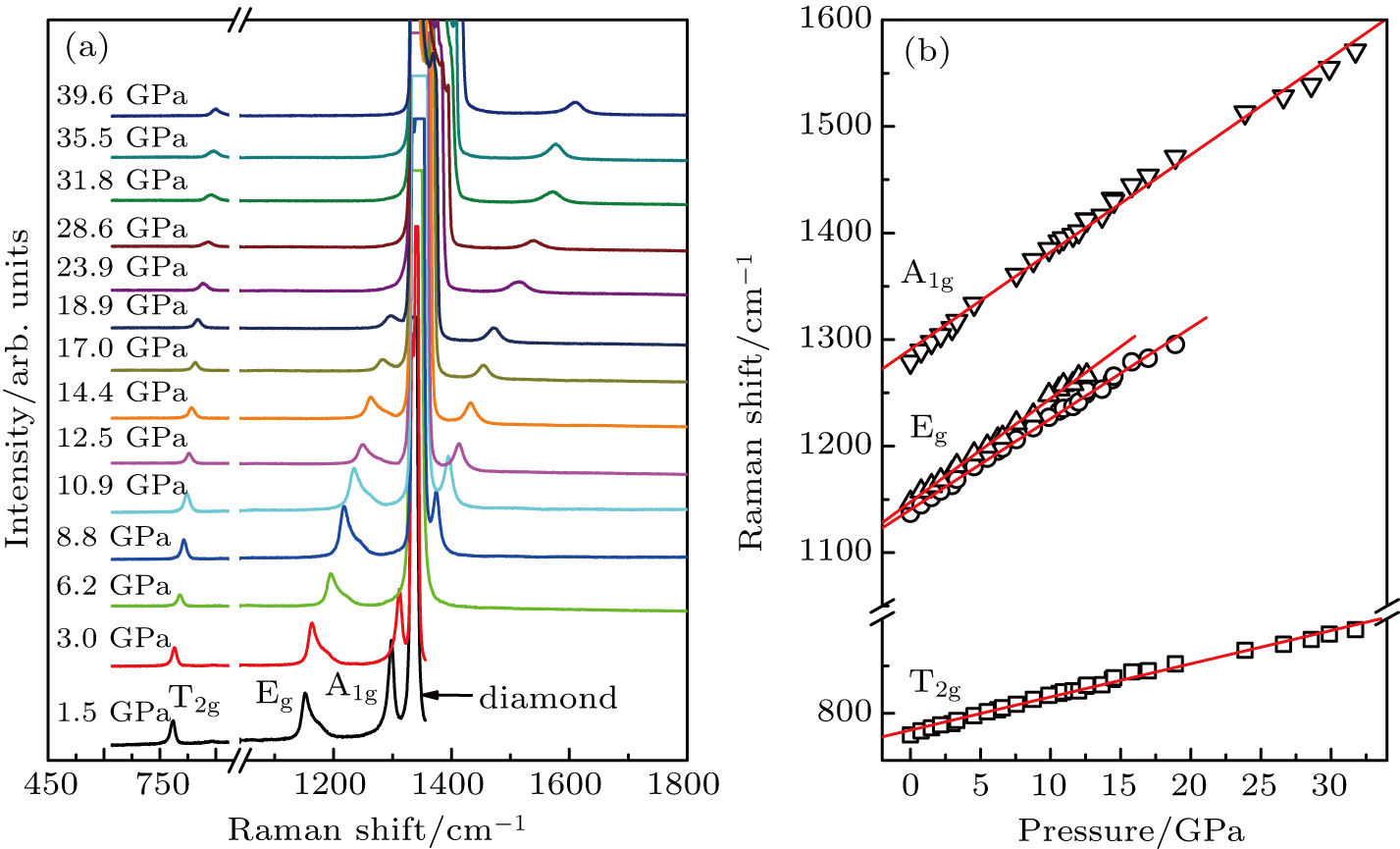† Corresponding author. E-mail:
Project supported by the National Natural Science Foundation of China (Grant Nos. 51572108, 51632002, 11504127, 11674122, 11574112, 11474127, and 11634004), the 111 Project, China (Grant No. B12011), the Program for Changjiang Scholars and Innovative Research Team in University, China (Grant No. IRT_15R23), and the National Found for Fostering Talents of Basic Science, China (Grant No. J1103202).
In situ Raman spectroscopy and x-ray diffraction measurements are used to explore the structural stability of CaB6 at high pressures and room temperature. The results show no evidence of structural phase transitions up to at least 40 GPa. The obtained equation of state with smooth pressure dependencies yields a zero-pressure isothermal bulk modulus B0 = 170 (5) GPa, which agrees well with the previous measurements. The frequency shifts for A1g, Eg, and T2g vibrational modes of polycrystalline CaB6 are obtained with pressure uploading. As the pressure increases, all the vibration modes have smooth monotonic pressure dependence. The Grüneisen parameter of Eg modes is the largest, indicating its largest dependence on the volume of a crystal lattice.
The hexaborides MB6 of the rare earth elements and the alkaline earth elements, such as YB6, CeB6, SrB6, and BaB6, have long been popular topics of theoretical and experimental studies.[1–4] These hexaborides crystallize in a CsCl-type structure with the alkaline earth element or rare earth atom and the octahedral B6 molecules. Among these hexaborides, the trivalent rare earth hexaborides show novel physical properties, such as YB6 with superconductivity, CeB6 with dense Kondo behavior, and SmB6 with intermediate valence state.[5–7] The divalent alkaline-earth hexaborides are renowned for having properties of high melting point and hardness, low density and coefficient of thermal expansion, and excellent chemical stability.[8–11]
At present, semiconductor CaB6 with high Curie temperature has received much attention.[12–14] CaB6 doped with small quantities of La contains no magnetic ions with an electron density of 7 × 1019 cm−3. At the magnetic ordering temperature about 600 K, its ground state is ferromagnetically polarized with a saturation moment of 
Pressure is an efficient method for changing the structures and properties of materials. Metal hexaborides such as LaB6 and EuB6 have been the focus in high-pressure study.[17,18] The LaB6 structure was indexed as Pban but was not observed in subsequent experiments. Several studies on CaB6 under extreme conditions have recently been reported. The earliest high pressure study of CaB6 was fulfilled by in situ resistance measurement and energy dispersive x-ray diffraction (XRD) with the sample loaded in the diamond anvil cell (DAC).[19] Two phase transitions under high pressure were discovered: an electronic transition occurs at 3.7 GPa, and a structural phase transition occurs at 12 GPa with the CsCl-type structure transformed to orthogonal structure. Subsequently, an unexpectedly complex crystal structure of CaB6 (space group: I4/mmm) was reported under high pressure and temperatures.[20] In theory, density functional theory (DFT) calculations predicted several structural transitions based on the dynamically stability.[21] However, the inconsistency between theory and experiment still exists, which needs further studies.
In this work, we report a joint of synchrotron XRD and Raman spectra study of CaB6 up to 40 GPa to explore its crystal structures and vibrational properties. Synchrotron XRD and Raman spectroscopy have proven to be powerful tools to investigate the structural properties under high pressure. The present work will also provide new insights into the structural stability of other metal hexaborides.
The powder sample was purchased from the Alfa Aesar Products, and loaded in the DAC with 


The Raman spectra were measured by an ActonSpetraPro500i spectrograph with a liquid-nitrogen-cooled charge-coupled device (CCD) detector. The excitation laser wavelength was 532 nm and laser power was 10 mW. The acquisition time for each experiment was 200 s, and the experimental data was analysed by OriginPro 8.5 software.
In situ high-pressure angle-dispersive XRD experiments were carried out at the 16-BM-D station of High Pressure Collaborative Access Team (HPCAT), Advanced Photon Source, Argonne National Laboratory. A focused monochromatic x-ray beam was used for measurement. Its diameter was 
As one of the divalent alkaline-earth hexaborides, CaB6 crystallizes into a CsCl-type structure with the space group of Pm-
Synchrotron XRD experiments are carried out to trigger the structural changes of CaB6 under high pressure. The representative XRD patterns of CaB6 with pressure uploading are shown in Fig. 



 | Fig. 2. Selected angle dispersive x-ray diffraction patterns of CaB6 with pressure range from 1.9 GPa to 35.0 GPa. The top dotted line represents the pattern upon decompression to ambient pressure. |
Raman spectroscopy has proven to be useful to study the vibrational properties and structural changes under high pressure.[30–32] We also have performed high-pressure Raman spectra to confirm the results from XRD patterns. The representation for the optical vibration modes of q = 0 (center of Brillouin zone) with point group Oh for CaB6 was predicted with group theory as follows:[33]



Figure
 | Fig. 4. (a) The Raman spectra of CaB6 measured under ambient pressure, and panels (b), (c), and (d) represent T2g, Eg, and A1g vibration modes, respectively. |
| Table 1.
The volume and corresponding errors of CaB6 at different pressures. . |
High-pressure Raman spectra are measured up to 40 GPa. The selected Raman spectra with pressure increasing are shown in Fig. 

| Table 2.
Assignment, frequencies, pressure coefficients, and mode-Grüneisen parameters of the Raman vibrational modes of CaB6. . |
The Raman frequency shift of the vibration modes with pressure is related to the change of bond length or bond angle. We have calculated the bond length in boron octahedron and bond length of the neighbouring boron octahedron under high pressure with the Material Studio program. Figure
In this work, we have successfully studied the structural stability and vibrational characteristics of CaB6 by means of in situ high pressure Raman spectra and synchrotron x-ray diffraction. As pressure increases up to 40 GPa, no phase transitions occur and the lattice constant decreases linearly with pressure. Upon compression, all the vibration modes have smooth monotonic pressure dependence. The Grüneisen parameter of Eg modes is the largest, indicating its largest dependence on the volume of a crystal lattice. Our experimental results reveal that the covalent network of CaB6 is difficult to break only under pressure conditions. To promote the occurrence of phase transition, it must be supplied with an alternative pathway to break the energy barrier and further studies are required.
| [1] | |
| [2] | |
| [3] | |
| [4] | |
| [5] | |
| [6] | |
| [7] | |
| [8] | |
| [9] | |
| [10] | |
| [11] | |
| [12] | |
| [13] | |
| [14] | |
| [15] | |
| [16] | |
| [17] | |
| [18] | |
| [19] | |
| [20] | |
| [21] | |
| [22] | |
| [23] | |
| [24] | |
| [25] | |
| [26] | |
| [27] | |
| [28] | |
| [29] | |
| [30] | |
| [31] | |
| [32] | |
| [33] |








